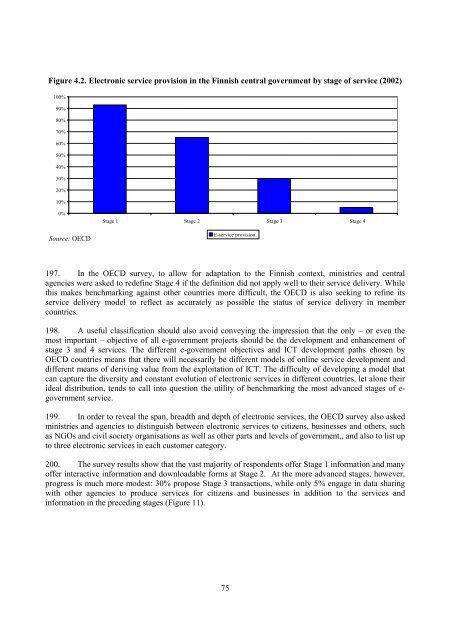e-GOVERNMENT IN FINLAND - ePractice.eu
e-GOVERNMENT IN FINLAND - ePractice.eu
e-GOVERNMENT IN FINLAND - ePractice.eu
You also want an ePaper? Increase the reach of your titles
YUMPU automatically turns print PDFs into web optimized ePapers that Google loves.
Figure 4.2. Electronic service provision in the Finnish central government by stage of service (2002)<br />
100%<br />
90%<br />
80%<br />
70%<br />
60%<br />
50%<br />
40%<br />
30%<br />
20%<br />
10%<br />
0%<br />
Source: OECD<br />
Stage 1 Stage 2 Stage 3 Stage 4<br />
E-service provision<br />
197. In the OECD survey, to allow for adaptation to the Finnish context, ministries and central<br />
agencies were asked to redefine Stage 4 if the definition did not apply well to their service delivery. While<br />
this makes benchmarking against other countries more difficult, the OECD is also seeking to refine its<br />
service delivery model to reflect as accurately as possible the status of service delivery in member<br />
countries.<br />
198. A useful classification should also avoid conveying the impression that the only – or even the<br />
most important – objective of all e-government projects should be the development and enhancement of<br />
stage 3 and 4 services. The different e-government objectives and ICT development paths chosen by<br />
OECD countries means that there will necessarily be different models of online service development and<br />
different means of deriving value from the exploitation of ICT. The difficulty of developing a model that<br />
can capture the diversity and constant evolution of electronic services in different countries, let alone their<br />
ideal distribution, tends to call into question the utility of benchmarking the most advanced stages of egovernment<br />
service.<br />
199. In order to reveal the span, breadth and depth of electronic services, the OECD survey also asked<br />
ministries and agencies to distinguish between electronic services to citizens, businesses and others, such<br />
as NGOs and civil society organisations as well as other parts and levels of government,, and also to list up<br />
to three electronic services in each customer category.<br />
200. The survey results show that the vast majority of respondents offer Stage 1 information and many<br />
offer interactive information and downloadable forms at Stage 2. At the more advanced stages, however,<br />
progress is much more modest: 30% propose Stage 3 transactions, while only 5% engage in data sharing<br />
with other agencies to produce services for citizens and businesses in addition to the services and<br />
information in the preceding stages (Figure 11).<br />
75
















